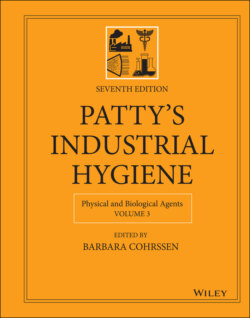Читать книгу Patty's Industrial Hygiene, Physical and Biological Agents - Группа авторов - Страница 18
2.2 Anthropogenic Sources
ОглавлениеX‐rays. Any electronic devices in which electrons fall through potentials of 10 kV or more produce X‐rays, and should be considered a potential source of exposure. Examples include medical diagnosis and therapy, industrial radiography for inspection, and X‐ray fluorescence and X‐ray diffraction analysis in research laboratories.
Accelerators. Intense beams of all radiation types are produced for medical radiation therapy, radioisotope production, neutron production for neutron activation analysis, and research.
Radioisotopes. This category includes sealed sources (for industrial uses such as gauging, inspection, food and drug sterilization, and medical radiation therapy), sealed neutron sources (for inspection, neutron activation analysis, and oil‐well logging), and unsealed radioisotopes (used in medical research, diagnosis, therapy, and generally in scientific and industrial research).
Nuclear reactors. Properly operating nuclear reactors produce negligible environmental radioactivity and exposure to the public. Nuclear reactors produce large quantities of neutrons in the fuel, resulting in the activation of many components in close proximity to the fuel. The fuel will contain both alpha‐ and beta‐emitting nuclides.
Technologically enhanced natural radioactivity. The concentration of radioactivity may be technologically increased to produce the so‐called TENORM (technologically enhanced naturally occurring radioactive material). Since this natural radioactivity is found in water and oil, in addition to rocks, coal, and soil, any scale that builds up in pipelines used for oil and gas production or for carrying water and brine in industrial facilities concentrates the radioactivity, especially radium. This can lead to significantly increased radiation exposure and inhalation hazards to workers when the pipelines are cut and the scale is dispersed as a radioactive aerosol.
Another source of TENORM is the phosphate industry. Phosphorous is usually associated with uranium because the two elements bind tenaciously together. Uranium concentrations of about 20–300 ppm are found in phosphate rock. Radiation from phosphate slag (which is used as an aggregate in road‐paving materials), phosphate fertilizers, and potash (which also contains relatively large amounts of 40K), thus must be considered by the industrial hygienist when evaluating possible occupational health risks in these industries.
Radioactivity is also found in relatively high concentrations in the fly ash and in the bottom ash of coal‐ and lignite‐burning boilers. Through this mechanism, many coal‐ and lignite‐fired electricity generating stations release more radioactivity to the environment than do nuclear power stations.
Workers who are explicitly involved with the use and maintenance of these radiation sources are not the only ones of concern to the industrial hygienist. The sources, once produced, must be transported from the manufacturer to the consumer. Additionally, radioactive waste is generally generated during the manufacture of the sradioisotopes as well as after they have been used. Thus, one must also apply the appropriate radiation safety standards and procedures to those workers involved in the transport of the radioisotopes and in the handling of waste materials.
